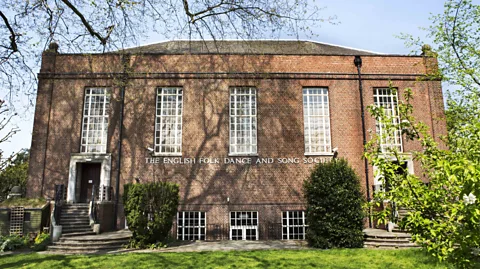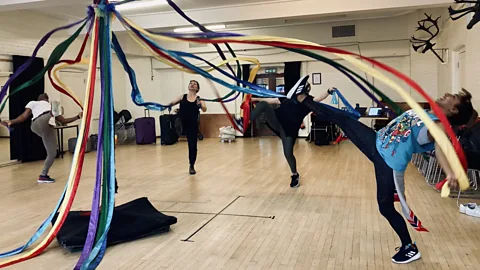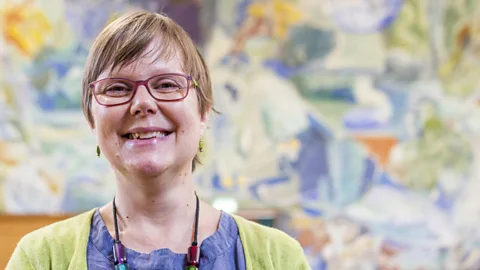The London venue reimagining British music
 Rosie Reed-Gold/EFDSS
Rosie Reed-Gold/EFDSSCamden's Cecil Sharp House has been questioning the very notion of what traditional British music means in the multicultural 21st Century.
"Hip-hop is the folk dance of today," said Natasha Khamjani, breathing heavily. They're both social dances created for crowd participation, both also existing on the fringes of the mainstream, she added. Khamjani was taking a quick break during a rehearsal of a high-energy performance blending Bollywood moves and English country dancing with the unmistakable bounce of hip-hop moves.
In an unexpected twist, Khamjani and her troupe were also dancing under a rainbow of swirling maypole ribbons – a sight more commonly associated with English village fetes rather than a basement in inner-city London. Nearby, the hum of Camden's traffic competed with the soundtrack of fiddle, banjo and beatboxing pumping from the speakers.
At first glance, this veritable mash-up of genres and cultures seemed an unlikely marriage. But for Khamjani, artistic director of Folk Dance Remixed, a collective putting a global spin on old-time English dances, a natural synergy exists. These are the dances of the people, bubbling up from the streets, pubs, village greens, dance halls and international communities that birthed them, Khamjani explained. An easy fit between age-old English country dances and house music exists, she pointed out. "It sounds weird but the steps are basically the same," she laughed, overlooked by imposing stag antlers mounted to the wall at the Cecil Sharp House.
Remixing maypole dancing is just one of the myriad ways that English folk culture is currently having a reboot, thanks to a new wave of switched-on folkies diversifying the scene. At the heart of this progressive movement is the Cecil Sharp House, a music venue and folk arts centre that's home to the English Folk Dance and Song Society (EFDSS) and where Folk Dance Remixed perform regularly.
 Zoey Goto
Zoey GotoNamed after Cecil Sharp, a folk music enthusiast who roamed the countryside of England and the US South collecting folk music and dances in the early 20th Century, this temple to vernacular culture threw open its Arts and Crafts-style doors in 1930. Nowadays, it competes with the colourful street theatre of neighbouring Camden Market, making it easy to this non-descript building without realising the hotbed of cultural boundary-pushing that lurks behind its terracotta brick facade.
Over the last few years, the EFDSS has ramped up its outreach efforts to engage new audiences, mixing diverse cultural traditions to create new interpretations of "Englishness". Projects have included teaming up with musician Kuljit Bhamra, pioneer of the British Bhangra sound, an upbeat musical style that mixes traditional Punjabi beats with Western pop, to uncover similarities between 18th-Century traditional Kentish jigs and Bhangra music. There have been sea shanty lessons with rap verses taught to schoolchildren; and feminist-themed pop-up events, including a recording of the podcast Thank Folk for Feminism at the house.
Certain projects have undeniably chimed easier than others. Take for example Queer Folk's Queer Ceilidh parties hosted at Cecil Sharp House, where evenings of LGBTQ ceilidh dancing and drag acts have proved a sell-out success. Musicians Sophie Crawford and George Sansome of Queer Folk also teamed up with the EFDSS to delve into the institution's song archives. They found a wealth of examples of "queer sex, romance and gender non-conformity, as well as signs of the mistreatment and persecution of trans and gender-non-conforming people", Sansome noted. "It's really powerful to see these parallels in songs from hundreds of years ago."
 Rosie Reed-Gold/EFDSS
Rosie Reed-Gold/EFDSSing me in the main hall at the Cecil Sharp House beneath a whimsical mural of folkloric creatures and abstract dancing figures, Katy Spicer, the chief executive and artistic director at EFDSS, pointed out that it is, however, a work in progress making the English folk scene truly inclusive. "In of diversity, ethnicity has been the hardest challenge" she said.
Somewhat ironically, it's possible to trace the roots of this reluctance back to the late 19th- and early 20th-Century folk music collectors, including Cecil Sharp himself. Their cannon of work focussed on the white, rural working-class dances and ballads, marking the genre out as a white heritage space and overlooking the cross-cultural exchanges that have always existed.
"There was perhaps a tunnel vision back then and histories not recorded, which no one questioned until recently. We're working to set the record straight," Spicer said, as a group of teenagers, part of the National Youth Folk Ensemble, shuffled onstage to tune violins ready for the evening's show. "Particularly when you have English in your title, you have to address what it means to be English and whose England is it">window._taboola = window._taboola || []; _taboola.push({ mode: 'alternating-thumbnails-a', container: 'taboola-below-article', placement: 'Below Article', target_type: 'mix' });
